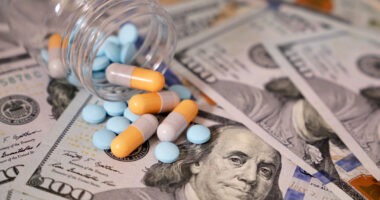How Long Will the Boom Times for Biotech Last?
Last year was a strong year for the US and European biotechnology sectors, led by a resurgence in initial public offerings and other financing into the industry. But what will drive the sector going forward? A recent analysis, offered by EY, at DCAT Week '15, examined public and private financing trends into the biotech sector.
How long will the bull market run? That is the pivotal question before the biotechnology sector, which is coming off a strong year in 2014 and which saw the biggest year for biotech financing in the history of the sector. So what are the key recent trends in private and public financing for the US and European biotech sector, and what may the industry expect in the year ahead? Glen Giovannetti, Global Life Sciences Leader for EY, addressed these questions at the education program, “PharmaChem Outlook: The Market Opportunities and Challenges,” at DCAT Week '15, organized by the Drug, Chemical & Associated Technologies Association (DCAT) and held March 16-19 in New York City.
Positive indicators in the biotech sector
“These are good times for biotech, with many positive signs from 2014,” said Giovannetti. Biotechs led the broader bull market in 2014, with the US biotech sector outperforming the broader stock market by 79% year over year and the European biotech sector outperforming the broader market by 61%. Biotech-based commercial leaders, defined by EY as publicly traded companies with revenues greater than $500 million, saw revenue gains of 38%. Biotech-based initial public offerings (IPOs), which had declined greatly following the financial crisis of 2008/2009 reached recent highs in 2014 as “IPOs blew past the benchmark set during the Genomics Bubble of 2000,” said Giovannetti. In terms of overall financing,”biotech was in the driver's seat,” said Giovannetti, as biotech companies fared favorably in terms of overall mergers and acquisitions (M&A) activity, upfront payments, and biobucks (referring to potential value from milestone payments in announced alliances/partnering deals). Investment was further buoyed by a resurgence in new drug approvals with the US Food and Drug Administration's Center for Drug Evaluation and Research approving 41 new molecular entities in 2014, the highest level in 17 years.
Another positive sign in 2014 was the increase in the market capitalization of US and European biotech companies. The market capitalization of US and European biotech companies more than doubled in the two years ending December 31, 2014, with the market capitalization of US-based biotech companies up 148% and the market capitalization of European-based biotech companies up 112%. In the US, the performance of large-cap companies (defined as companies with market capitalization of greater than $10 billion), mid-cap companies (defined as companies with a market capitalization of $2 billion to $10 billion), and small-cap companies (defined as companies with a market capitalization of $200 million to $2 billion) were closely aligned during this period, but the performance of micro-caps (defined as companies with a market capitalization of less than $200 million) lagged comparative to larger cap companies (see Figure 1 at end of article). In Europe, biotech companies performed better than the overall market (see Figure 2 at end of article). Among US commercial leaders (defined as companies with revenues greater than $500 million), companies posting strong revenues gains in 2014 compared to 2013 were Pharmacyclics (revenue gains of 180%), Gilead Sciences (up 122%), Medivation (up approximately 95%), Salix Pharmaceuticals (up 48%), Incyte Corporation and Alexion Pharmaceuticals (each up 44%), Biogen (up 40%), and Regeneron Pharmaceuticals (up 34%). “As strong as the performance was for US commercial leaders, the market values of non-commercial leaders has soared over the past two years [two-year period ending December 31, 2014],” noted Giovannetti. Figure 3 (see end of article) shows that trend. Favorable investor sentiment toward the biotech sector is further underscored by the number of pre-commercial companies with market capitalization of more than $1 billion (see Table I below).
| Table I: Examples of Pre-Commercial (Companies w/o a Commercial Product) with Market Capitalization of Greater Than $1 Billion | |||
| Company | Market Capitalization as of Dec. 31, 2014 | Lead Product Status (as of Dec. 31. 2014) | Therapeutic Area |
| Alnylam Pharmaceuticals | $7.462 Bn | Phase III | Multiple |
| Puma Biotechnology | $5.706 Bn | Phase III | Cancer |
| Juno Therapeutics* | $4.722 Bn | Phase I/II | Cancer |
| Agios Pharmaceuticals* | $4.104 Bn | Phase II | Cancer |
| Receptos* | $3.793 Bn | Phase III | Multiple |
| Intercept Pharmaceuticals | $3.332 Bn | Phase III | Hepatic |
| Acadia Pharmaceuticals | $3.168 Bn | Phase III | Multiple |
| bluebird bio* | $2.876 Bn | Phase III | Genetic |
| Kite Pharma* | $2.413 Bn | Phase II | Cancer |
| Clovis Oncology | $1.904 Bn | Phase III | Cancer |
| FibroGen* | $1.582 Bn | Phase III | Multiple |
| Ophthotech* | $1.510 Bn | Phase III | Ophthalmic |
| Chimerix* | $1.468 Bn | Phase III | Infection |
| Auspex Pharmaceuticals* ** | $1.448 Bn | Phase III | Central nervous system/neurology |
| Ultragenyx Pharmaceutical* | $1.400 Bn | Phase III | Multiple |
| Radius Health* | $1.281 Bn | Phase III | Musculoskeletal |
| Acceleron Pharma* | $1.257 Bn | Phase II/III | Cancer |
| Achillion Pharmaceuticals | $1.228 Bn | Phase II | Infection |
| Karyopharm Therapeutics* | $1.224 Bn | Phase II | Cancer |
| TetraPhase Pharmaceuticals* | $1.217 Bn | Phase III | Infection |
| Avalanche Biotechnologies* | $1.213 Bn | Phase II | Ophthalmic |
| Merrimack Pharmaceuticals | $1.196 Bn | Phase III | Cancer |
| NewLink Genetics | $1.111 Bn | Phase III | Cancer |
| OvaScience | $1.052 Bn | Development | Women's health |
| Sangamo BioSciences | $1.040 Bn | Phase II | Multiple |
| * Company had an initial public offering in 2013 or 2014 ** Teva Pharmaceutical Industries agreed to acquire Auspex Pharmaceuticals for $5.3 billion in March 2015. Source: EY and Capital IQ |
|||
In aggregate, the US biotech sector recorded its highest financing levels in 2014 (see Figure 4 at end of article) led by financing raised from debt, follow-ons and other offerings, and IPOs. Like the US, the European biotech sector reached its highest financing level in 2014 (see Figure 5 at the end of article). The year 2014 was marked by a resurgence in biotech-based IPOs, which was particularly strong in the first quarter of 2014 and that continued a trend begun in the second quarter of 2013 as both the number and total amount raised by US biotechs reached a new high in 2014, surpassing levels set in the Genomics Bubble of 2000 (see Figure 6 at the end of article). European biotechs also performed well, delivering the highest number of IPOs in 2014, more than 30 with more than $3.0 billion raised.
Another promising sign in 2014 for the US and European biotech markets was the rise of innovation capital, defined by EY as the amount of equity raised by companies with revenues less than $500 million, which increased in the US (see Figure 7 at end of article) and reached its highest level in Europe in 2014 (see Figure 8 at the end of article). The US still dominates in innovation capital with more than $20 billion raised in 2014 compared to the EU with more than $5 billion, according to EY estimates. US biotechs attracted the most venture capital investment in 2014 since the financial crisis of 2008/2009 although venture capital financing in the US accounted only for 10% of overall US biotech financing in 2014. Early-stage venture capital investment was the second highest ever in 2014, surpassed only by levels reached in 2007 (see Figure 9 at end of article). “European venture capital investment was also strong and was driven in part by record-early-stage investments,” said Giovannetti. On a geographic basis, the biotech centers of New England and the San Francisco Bay area attracted the majority of innovation capital in the US, and UK biotechs attracted the majority of EU innovation and venture capital.
Another favorable indicator was the amount raised by biotech companies in 2014 from strategic alliances and partnering deals. In terms of biotech financing, so-called “biobucks,” referring to the potential value (i.e., milestone payments) from US and European strategic alliances, both pharma–biotech and biotech–biotech deals, reached nearly $50 billion in 2014, setting recent highs in both the amount of biobucks and the number of deals, noted Giovannetti.
On the M&A front, the large pharmaceutical companies were responsible for many of the larger deals in acquiring smaller players in 2014, led by Merck & Co.'s $9.5 billion acquisition of Cubist Pharmaceuticals (a deal that was completed in 2015), Roche's $8.3 billion acquisition of InterMune, and Merck & Co.'s $3.85 billion acquisition of Idenix Pharmaceuticals. Table II (see below) highlights select M&A from 2014. At the same, the large pharmaceutical companies have also been focusing their own assets with select deals. A key deal was the three-part transaction between Novartis and GlaxoSmithKline (GSK), which was announced in 2014 and closed earlier this year, under which Novartis and GSK combined their consumer heatlhcare businesses into a joint venture, GSK divested its oncology products to Novartis in a deal value at more than $16.0 billion, and GSK acquired Novartis’ vaccine business (excluding flu) for approximately $7.1 billion. In a related separate transaction, Novartis sold its animal health business to Eli Lilly for $5.4 billion, a deal that was announced in 2014 and completed earlier this year. Also in 2014, Merck & Co. sold its consumer healthcare business to Bayer for $14.2 billion. In a deal completed in late February 2015, Mylan acquired Abbott Laboratories’ non-U.S. developed markets specialty and branded generics business for approximately $5.3 billion. In February 2015, Pfizer announced the $17 billion acquisition of Hospira, a deal that is expected to close in the second half of 2015.
| Table II: Select Mergers & Acquisitions of Pharmaceutical/Biopharmaceutical Targets in 2014 | ||||
| Company | Country | Acquired Company | Country | Total value ($US millions) |
| Merck & Co. | US | Cubist Pharmaceuticals | US | $9,500 |
| Roche | Switzerland | InterMune | US | $8,300 |
| Merck & Co. | US | Idenix Pharmaceuticals | US | $3,850 |
| Otsuka Pharmaceutical | Japan | Avanir Pharmaceuticals | US | $3,500 |
| Meda | Sweden | Rottapharm | Italy | $3,093 |
| Forest Laboratories | US | Aptalis Pharmaceuticals | US | $2,900 |
| Endo International | Ireland | Auxilium Pharmaceuticals | US | $2,600 |
| Johnson & Johnson | US | Alios BioPharma | US | $1,750 |
| Roche | Switzerland | Seragon Pharmaceuticals | US | $1,725 |
| Baxter International | US | Chatham Therapeutics | US | $1,410 |
| Mallinckrodt | US | Cadence Pharmaceuticals | US | $1,400 |
| AMAG Pharmaceuticals | US | Lumara Health | US | $1.025 |
| Baxter International | US | AesRx | US | $843 |
| BioMarin Pharmaceutical | US | Prosenax | Netherlands | $840 |
| Teva Pharmaceuticals | Israel | Labrys Biologics | US | $825 |
| Bristol-Myers Squibb | US | iPierian | US | $725 |
| Total potential value includes up-front, milestone and other payments from publicly available sources Source: EY, Capital IQ, Medtrack, and company news |
||||
Giovannetti noted that one driver in part for the M&A by the large pharmaceutical companies is to close what has been termed as a “growth gap” among the large pharmaceutical companies comparative to the performance of the broader pharmaceutical market. Using analysts' forecasts for Big Pharma sales of a compound annual growth rate (CAGR) of 1% to 2% through 2017 and IMS projections on global pharmaceutical industry CAGR of 4–7%, Big Pharma faces a growth gap of approximately $100 billion, referring to the amount of Big Pharma sales that would be needed to keep pace with overall global pharmaceutical industry growth.
Positive indicators in the biotech sector
In looking at 2015, Giovannetti said there are several issues to consider. The first is how long and to what degree the IPO window will remain open after experiencing a long run. “The biotech IPO window is nearing its end, but the market will stay receptive for differentiated stories and technologies,” said Giovannetti. Venture capital has returned to the biotech market and will likely continue. Also, the pharmaceutical majors' growth gap will likely drive an increase in deals, both in terms of M&A and alliances, concluded Giovannetti.
Note: See Figures 1 to 9 below.
Thank you to the following companies for sponsoring DCAT's 2015 PharmaChem Outlook: The Market Opportunities and Challenges education program during DCAT Week ’15.

| Figure 1: Market Capitalization of UB-based Biotech Companies, by Company Size, 2013-2014 |
 |
Figure 2: Market Capitalization of European-based Biotech Companies Relative to Leading Indices, 2013-2014
 |
Figure 3: Market Capitalization of US Public Biotech, 2013-2014
Commercial leaders are defined as companies with revenues greater than $500 million.
Other companies refer to companies with revenues less than $500 million.
 |
Figure 4: Financing for US-based Biotech Companies, 2004 to 2014
 |
Figure 5: Financing of European-based Biotech Companies, 2004-2014.
 |
Figure 6: Number of Initial Public Offerings (IPOs) and Amount Raised through IPOs for US-based Biotech Companies.
 |
| Source: EY |
Figure 7: Capital Raised by US-based biotech companies, 2006-2014.
Innovation capital defined as capital raised by companies with revenues of less than $500 million.
Commercial leaders defined as companies with revenues of greater than $500 million.
 |
Figure 8: Capital Raised by European-based Biotech Companies, 2006 to 2014
Innovation capital is capital raised by companies with revenues of less than $500 million.
Commercial leaders are companies with revenues of greater than $500 million.
 |
Figure 9: Early-stage Venture Capital Investment of US-based Biotech Companies, 2001-2014
 |
| Figure 1: Market Capitalization of UB-based Biotech Companies, by Company Size, 2013-2014 |
 |





